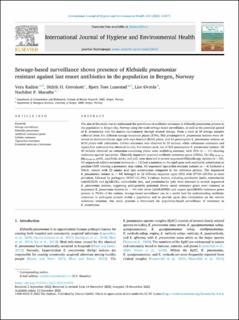| dc.contributor.author | Radisic, Vera | |
| dc.contributor.author | Grevskott, Didrik Hjertaker | |
| dc.contributor.author | Lunestad, Bjørn Tore | |
| dc.contributor.author | Øvreås, Lise | |
| dc.contributor.author | Marathe, Nachiket | |
| dc.date.accessioned | 2023-02-15T12:21:22Z | |
| dc.date.available | 2023-02-15T12:21:22Z | |
| dc.date.created | 2022-11-16T14:33:14Z | |
| dc.date.issued | 2022 | |
| dc.identifier.issn | 1438-4639 | |
| dc.identifier.uri | https://hdl.handle.net/11250/3051105 | |
| dc.description.abstract | The aim of this study was to understand the prevalence of antibiotic resistance in Klebsiella pneumoniae present in the population in Bergen city, Norway using city-scale sewage-based surveillance, as well as the potential spread of K. pneumoniae into the marine environment through treated sewage. From a total of 30 sewage samples collected from five different sewage treatment plants (STPs), 563 presumptive K. pneumoniae isolates were obtained on Simmons Citrate Agar with myo-Inositol (SCAI) plates, and 44 presumptive K. pneumoniae isolates on SCAI plates with cefotaxime. Colistin resistance was observed in 35 isolates, while cefotaxime resistance and tigecycline resistance was observed in only five isolates each, out of 563 presumptive K. pneumoniae isolates. All 44 isolates obtained on cefotaxime-containing plates were multidrug-resistant, with 25% (n = 11) showing resistance against tigecycline. Clinically important acquired antibiotic resistance genes (ARGs), like blaCTX-M-14, blaCTX-M-15, qnrS1, aac(3)-IIe, tet(A), and sul1, were detected in several sequenced Klebsiella spp. isolates (n = 53). All sequenced colistin-resistant isolates (n = 13) had a mutation in the mgrB gene with nucleotide substitution at position C88T creating a premature stop codon. All sequenced tigecycline-resistant isolates (n = 4) harbored a Tet(A) variant with 22 amino acid (aa) substitutions compared to the reference protein. The sequenced K. pneumoniae isolates (n = 44) belonged to 22 different sequence types (STs) with ST730 (29.5%) as most prevalent, followed by pathogenic ST307 (11.4%). Virulence factors, including aerobactin (iutA), enterobactin (entABCDEFS and fepABCDG), salmochelin (iro), and yersiniabactin (ybt) were detected in several sequenced K. pneumoniae isolates, suggesting pathogenicity potential. Heavy metal resistance genes were common in sequenced K. pneumoniae isolates (n = 44) with silver (silABCEFPRS) and copper (pcoABDRS) resistance genes present in 79.5% of the isolates. Sewage-based surveillance can be a useful tool for understanding antibiotic resistance in pathogens present within a population and to provide up-to date information on the current resistance situation. Our study presents a framework for population-based surveillance of resistance in K. pneumoniae. | en_US |
| dc.language.iso | eng | en_US |
| dc.publisher | Elsevier | en_US |
| dc.rights | Navngivelse 4.0 Internasjonal | * |
| dc.rights.uri | http://creativecommons.org/licenses/by/4.0/deed.no | * |
| dc.title | Sewage-based surveillance shows presence of Klebsiella pneumoniae resistant against last resort antibiotics in the population in Bergen, Norway | en_US |
| dc.type | Journal article | en_US |
| dc.type | Peer reviewed | en_US |
| dc.description.version | publishedVersion | en_US |
| dc.rights.holder | Copyright 2022 The Author(s) | en_US |
| dc.source.articlenumber | 114075 | en_US |
| cristin.ispublished | true | |
| cristin.fulltext | original | |
| cristin.qualitycode | 2 | |
| dc.identifier.doi | 10.1016/j.ijheh.2022.114075 | |
| dc.identifier.cristin | 2074995 | |
| dc.source.journal | International Journal of Hygiene and Environmental Health | en_US |
| dc.relation.project | Norges forskningsråd: 329514 | en_US |
| dc.relation.project | Norges forskningsråd: 315266 | en_US |
| dc.identifier.citation | International Journal of Hygiene and Environmental Health. 2022, 248, 114075. | en_US |
| dc.source.volume | 248 | en_US |

